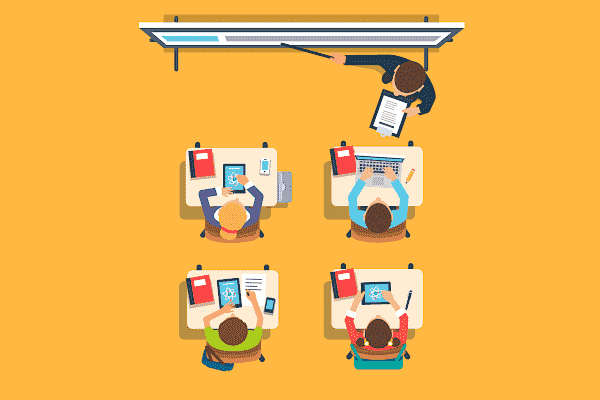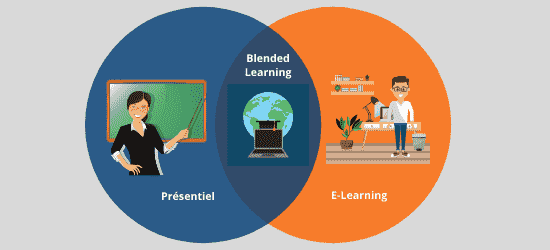Blended learning: Is it right for your company?
what is blended learning?
Blended learning combines the benefits of two training environments—conventional face-to-face learning and eLearning—to meet the increasing demands of new-age learners. Blended learning extends learning beyond the classroom walls, allowing students to access materials both online and off. This helps to engage all kinds of learners, including those who learn best in a traditional classroom setting as well as those who work best with semi-autonomous, computer-based instruction. While classroom learning provides instant face-to-face interaction, online learning provides self-paced tailored learning using interactive media such as games, videos, tutorials, quizzes, and so on, all available from the learner's home page in a learning management system (LMS).

Here are the five most common types of blended learning frameworks:
- 1. Flipped Classroom Model: Teachers can use flipped classrooms to help students complete educational assignments and to encourage students as they practice implementing concepts they have acquired independently. In a mixed learning setting, teacher-led activities can take place in person while independent study takes place at home using online modules or video lectures.
- 2. Face-to-Face Driver Model: This blended learning approach is most similar to traditional classroom training since most of the instruction takes place in a classroom environment. This strategy provides learners with customized, individualized assistance if they are having difficulty grasping new topics or are falling behind in the training curriculum.
3. Rotational Model: Learners in the rotational blended learning approach are required to stick to a set timetable and rotate between self-paced online study and face-to-face contact. The timetables are still variable.- 4. Flex Model: The Flex blended learning model provides learners with a flexible and customizable learning experience that is adapted to their unique requirements. With this paradigm, online learning takes the lead as the primary transmitter of content in the overall learning experience, while instructors offer critical support in small-group situations. Students can adapt the pathways and timetables they follow throughout the learning process with flex models.
- 5. Enriched Virtual Model: The enriched virtual blended learning model is quite similar to the flex model, except it includes more online training. This paradigm has grown in popularity in this era of remote work. However, unlike the flex model, learners must attend a planned Instructor-led classroom session, which can take place in either real or virtual classrooms. This technique enhances remote learning by allowing learner-instructor interaction via online platforms.
Is it right for your company?
Since the introduction of web-based courses in the late 1990s, eLearning and
blended learning have become hot topics in higher education and business
training. According to a survey conducted by the European University Association
(EUA) a few years ago, all higher education establishments examined had started
using eLearning. What is most interesting is that 91% of the institutes examined
used blended learning, which integrates eLearning with traditional
instruction.
E-learning is no doubt the current buzzword in education, and for one simple
reason: it helps both students and businesses. For students, eLearning means
wider access to courses across geographical boundaries, as well as the
opportunity to learn whenever and wherever they want. For businesses, it means
offering cross-border access to learning content, saving time and money while
improving reach.
It appears to be a win-win situation for both parties. However, according to the
EUA report, there is a huge disparity between what students desire and what
organizations offer. While there are various variables that contribute to the
gap, one of the most significant is people's innate resistance to change. In the
field of eLearning, studies show that about 10% to 15% of professors in higher
education schools are open to adopting eLearning tools and techniques. The
reluctant majority, estimated to be 70%–80%, has to be shown that eLearning
would benefit them.
And hence, rather than a dramatic shift from face-to-face to online learning, a
better way out is gradually evolving by taking the middle path, i.e., not giving
up the comfort of face-to-face interaction while slowly and steadily adapting to
new online technology and entering the world of digital content. In other words,
blended learning, or learning that combines the effectiveness of face-to-face
and online training methods, would seem to be the right investment for
enterprises in a variety of ways. It can benefit the organization in terms of
better acceptance by employees, particularly those who are not particularly
tech-savvy, increased engagement, and a wider reach. Blended learning also
promotes teamwork and improves evaluation procedures.


Enhance feedback
Blended learning is another way to get a lot of feedback. Periodic online examinations, quizzes, and projects are used to assess an employee's retention. Furthermore, an employee can call the teacher for assistance in addressing questions. A teacher may identify and correct errors before examining employees, while at the same time increasing motivation.

LEAVE A REPLY
Your email address will not be published. Required fields are marked *